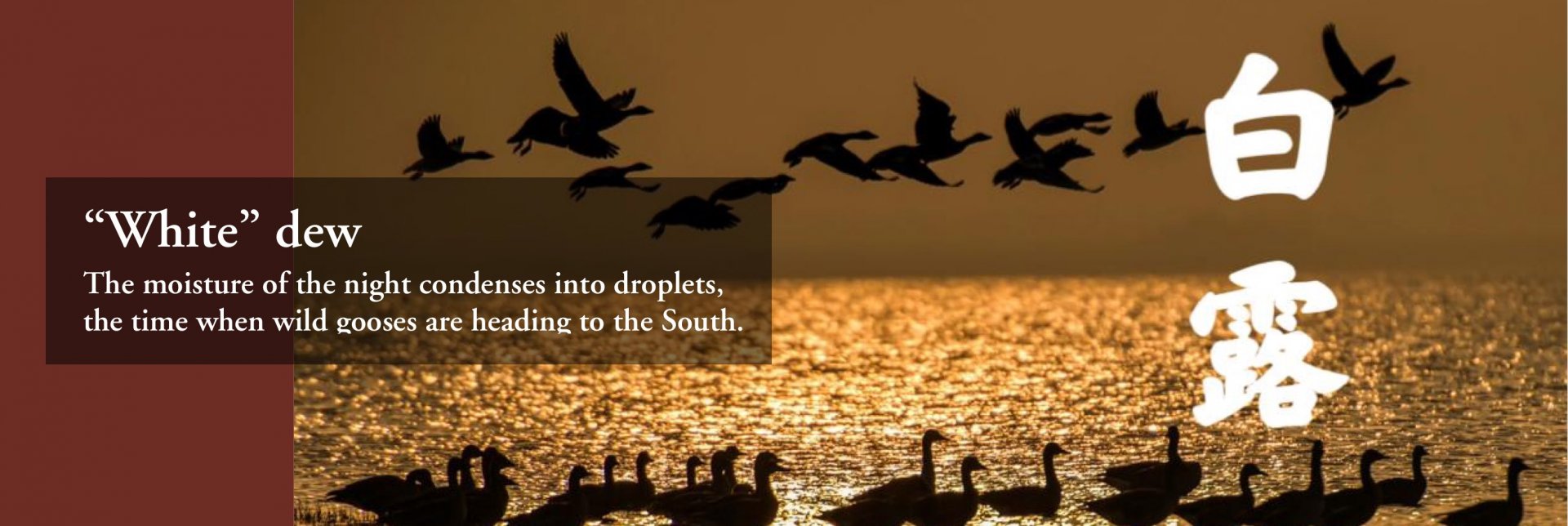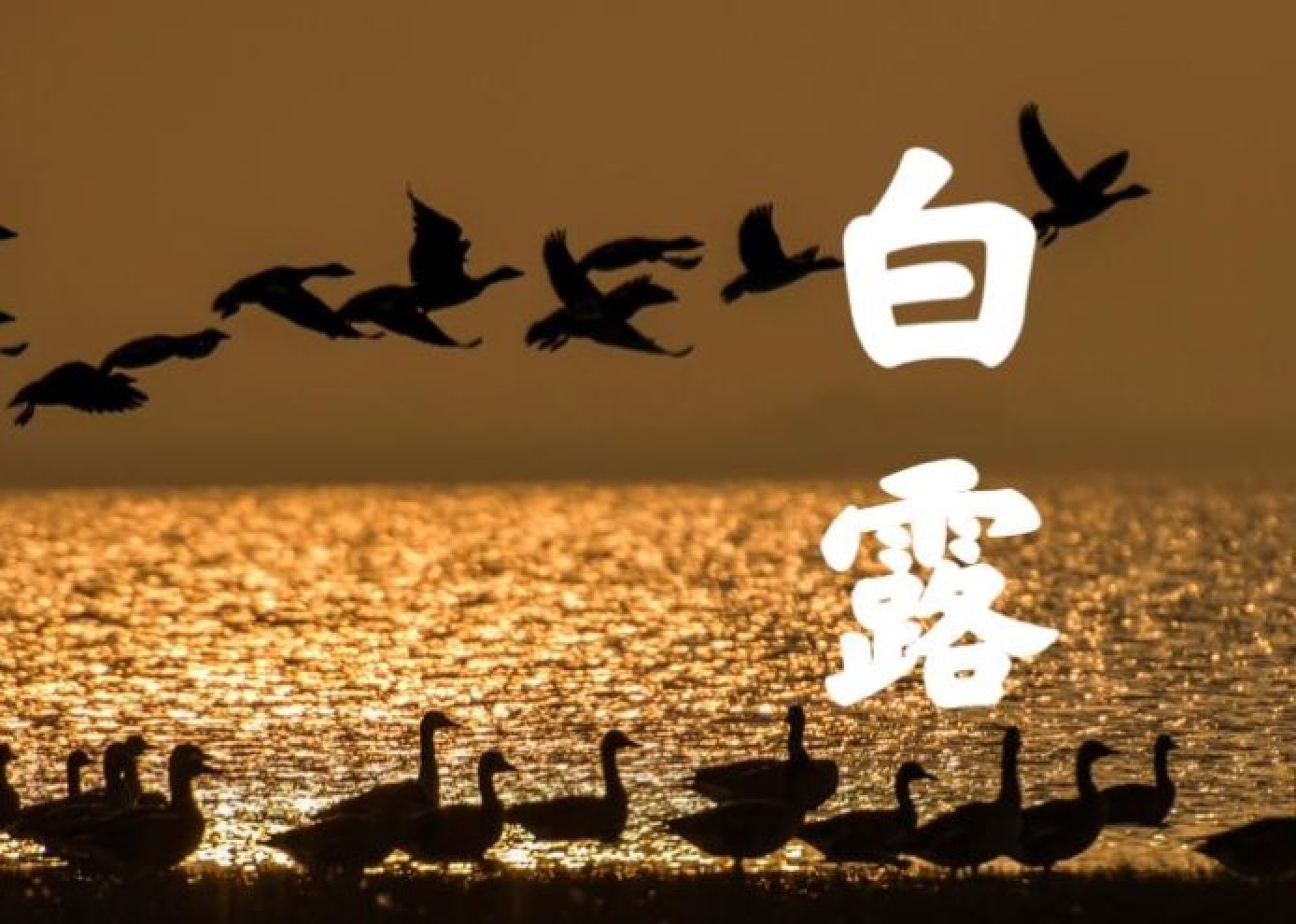“White” dew:
The moisture of the night condenses into droplets, the time when wild gooses are heading to the South.
Dew is often formed during the low temperature period of the night. After dawn, when temperature rises in the sunshine, dew soon evaporates. The ephemeral nature of morning dew makes one ruminate about the transience in life. Even warlords like Cao Cao (曹操, 155-220) once lamented, “It is a rare chance to have wine and sing together. Days are just like the morning dew, which disappears so soon (對酒當歌,人生幾何?譬如朝露,去日苦多)!” Interestingly, ancient Chinese believed that dew, which would soon evaporate, was beneficial for longevity. The most famous case was Emperor Wu of Han Dynasty (漢武帝劉徹, 156–87 BC), who was extremely enthusiastic in finding magical ways that led to immortality as well as spending enormous resources in building palaces and architecture for receiving deities and gods. The Bowl for dews (承露盤) in Jianzhang Palace (建章宮) is one of those constructions. Yan Shigu’s (顏師古, 581-645) annotation of Book of Han (《漢書》) quoted the illustration from Sanfu Gushi (The Story of Three Important Officials, 《三輔故事》) that, “In Jianzhang Palace, there was a place called Bowl for Dew, which was made of copper. It was of twenty Zhang’s height (二十丈, approximately 40 meters), which required seven people to encircle it (大七圍). There was a statue of god’s palm to carry water from the dew so that the emperor could drink it along with jade powder (建章宮承露盤,高二十丈,大七圍,以銅為之,上有仙人掌承露,和玉屑飲之).” It is clear that drinking this is for immortality. Another story from Eastern Han Dynasty Guo Xian’s (郭憲, ?-?) book A look to mystery (洞冥記) said that a poet called Dongfang Shuo (東方朔, 160-93 BC) offered the gift of dew of three different colours (black, yellow, and blue) to Emperor Wu of Han Dynasty. The emperor offered some to the government officials. Among those of all ages who tasted that had their illness cured. (帝遍賜群臣,群臣得露嘗露者,老而皆少,疾者皆除).

It is now impossible to verify the validity of these legends about the effects of dew. Nonetheless, in the Classic of Chinese medicine, Compendium of Materia Medica (Bancao Gangmu, 本草鋼目 written in the 1600 AD in Ming Dynasty), there is a chapter on “liquid” (水部), which illustrates three entries underlying “dew” (lu, 露), namely “dew water” (lushui, 露水); “sweet dew water” (Ganlu, 甘露) and “dew water as sweet as honey” (甘露蜜). The author Li Shizhen (李時珍, 1518-1593) cited Tang Dynasty medical book A Footnote to Herbal Medicine (Bencao Shiyi, 《本草拾遺》) written by scholar Chen Zangqi (陳藏器, 687-757) that, “one could collect dew in the autumn in a bowl, and boil it with the same method of making syrups. This can help us to attain longevity through enabling us to reduce hunger. (秋露繁時,以盤收取,煎如飴,令人延年不饑。)” We can see that in the history of Chinese medicine, the understanding of dew had already transcended from their physical qualities to the association with various skills and magic to promote longevity. This can be regarded as a culturally specific tradition.
The formation of such cultural tradition is based on the ancient Chinese understanding of Qi (氣) of Yin and Yang (陰陽) from the earth and the heaven. Water has a diversity of forms, thus giving rise to its special status in the understanding of twenty-four solar terms. When “Yang” Qi is rising in the early spring, it comes with the solar term of Rain Water (雨水); when the “Yin” Qi is rising, water condenses into droplets, which is described as the solar term White Dew (白露) in the mid-autumn; in winter, we even have the solar term of Lesser Snow (小雪) and Greater Snow (大雪). Probing further, one can know that even as early as in the solar term of the beginning of autumn (立秋), there was already a feature that “White Dew Appears” (白露生); nonetheless, in the solar term of White Dew (白露), dew is formally regarded as a signifying feature. The weather is colder at that moment, and water vapour emitted from the ground condenses into dew under the low temperature. Li Shizhen explained in this way, “dew is the liquid form of Yin Qi, which transmits through the air in the night and attaches to everything along the road. (露者,陰氣之液也,夜氣著物而潤澤於道傍也。)” The crystal-like droplets are also a metaphor of the vicissitudes of the four seasons, which inspires many poets. Therefore, the Book of Poetry (Shijing, 《詩經》) wrote, “the reeds and rushes are deeply green, and the white dew is turned into hoarfrost. (蒹葭蒼蒼,白露為霜。)” Du Fu (杜甫, 712-770) also lamented, “after tonight, dew becomes white, and the moon is brighter in my hometown. (露從今夜白,月是故鄉明。)”

These poems are beautiful and popular. Nonetheless, I would like to ask a question: why the dew, which is actually clear droplets, is always described as “white”? The book An Investigation of Features of the Seventy-two Sectors of a Year (《月令七十二候集解》 written in Yuan Dynasty in the 14th Century) provided an explanation, “the autumn belongs to the element of metals in the five-element system, and metals are usually white in colour. Therefore, when the weather is cold, dew condenses and becomes white. (秋屬金,金色白,陰氣漸重,露凝而白也。)” However, from the modern science of colours, this explanation seems not reliable. After all, “Jin” (金, gold), which is one of the five elements in Chinese theory, actually refers to all types of metals of different colours, and actually metals are seldom “white” in colour, not to mention that dew which is actually crystal clear and colourless. Therefore, I would like to propose a theory based on ancient Chinese theory of the five elements: here, “white” is not a colour, but is referring the direction of West, and ancient Chinese put various phenomena under the category of “metal”. Thus, “autumn” was categorized into the element of “Jin” (metals). As “autumn” is classified as “metal”, the same was the case of “white” and “west” which are classified as the element of “metal” in Chinese five-element theories, then we could now understand that why such ideas referring one another interchangeably in ancient Chinese texts. For example, the famous Tang Dynasty poem Arriving the top of the Stork Tower (〈登鸛雀樓〉) says, “The white sun is going down along the mountain. (白日依山盡)” Here the “white” seems not to be described as the colour of the sun, but should be more sensibly understood as a reference to the direction of the west, therefore it refers to the description that the sun goes down the mountain at dusk. Therefore, the “white” (白) in “White Dew” (白露) should not be understood as a colour. It actually refers to the connection between the idea of how Chinese associate various phenomena in terms of the five-element theories. Therefore, while the modern translation of the solar term is often called “White” dew, some translation of the solar term simply put it as “dew”. I believe that this translation puts more emphasis on the crystal-clear nature of dew droplets, but not “white” as a colour, which in my opinion is a better way to translate this solar term.

As ancient Chinese believed that a droplet of dew is containing holy “Qi” from the earth and the heaven, it is not surprising that ancient Chinese valued the solar term of White Dew so much, and develop many rituals for this solar term. For example, now we regard the Mid-autumn festival as “the festival in the eighth month”, but in ancient times, it also referred to the day of White Dew. There is a poem by Yuan Zhen (元稹, 779-831) in his poem sequel on twenty four solar terms titled “White Dew, the Festival of the Eighth Month (白露八月節)”. Although we illustrated that “white” in “White Dew” might not be referring to colours, laymen still regard “white” colour as the essential elements in this festival. Therefore, there is a proverb “in White Dew, one should eat five white foodstuff so that all kinds of disease won’t visit you. (白露時節吃五白,大病小病都不來。)” The “five white foodstuff” (五白) refers to water lily (百合), white fugus (銀耳), white carrot (白蘿蔔), bean curd (豆腐) and Muscovy duck (番鴨). In Southeastern China, some areas even have a list of seasonal “three-white foodstuff” (三樣白) or “ten-white foodstuff” (十樣白) for the solar term of White Dew so that these white foodstuffs match the “white” in the solar term. The main purpose is to take nutrition that is good for health. There are even practices of collecting dew water for drinking. There are many artistic names for this, for examples, “tea made of dews from the maple trees” (楓靈茶), “cool fragrant droplets” (冷香丸) and “rose dew” (玫瑰露) mentioned in The Dream of the Red Chamber (紅樓夢).

The arrival of White Dew implies the swapping of “Yang Qi” and “Yin Qi”, which is evident in the more extreme temperature between daytime and nighttime. Even though there are occasional abnormal heat strokes in the daytime of autumn (which is nicknamed “Autumn Tiger” ,秋老虎), it won’t last to the nighttime. At night, temperature becomes much lower, as proverb says, “autumn night after White Dew is becoming cooler and cooler. (白露秋風夜,一夜涼一夜。)” Around the time of the white dew, autumn is becoming more obvious. The weather is becoming cold and wild gooses are heading south to escape the cold weather. This is a signifying feature of the solar term White Dew. As it is becoming closer to the end of the year, the birds migrate to adapt to the change of the weather due to the change of the “Qi”, which could be associated with the natural rhythm relevant to human beings and even all lives on the Earth. Following the rhythm is a guiding principle of good living as well as the basis of aesthetics. From this sense, how can we stop appreciating twenty-four solar terms (including White Dew) as the tranquil and peaceful symphony of the universe?
Reference
Journal Article
1. 吳彬瑛:〈二十四節氣民俗文化特徵研究〉,《文化創新比較研究》,第29期(2019年),頁36-37。
2. 宋英傑、隋偉輝、孫凡迪、齊鵬然:〈基於氣候和物候的二十四節氣英文譯名研究〉,《中國非物質文化遺產》,第1期(2022年),頁58-73。
News or Magazine Article
1. 孟揚、曹怡晴:〈露從今夜白 秋向此時分〉,《人民日報》,2022年9月6日,第13版。
All articles/videos are prohibited from reproducing without the permission of the copyright holder.




Welcome to leave a message:
Please Sign In/Sign Up as a member and leave a message